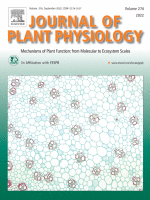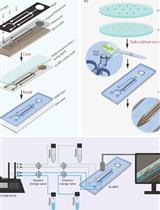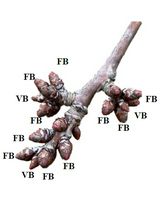- EN - English
- CN - 中文
Quantification of Ethylene Production in Leaf and Bud Tissue of the Subtropical Tree Crop Litchi (Litchi chinensis Sonn.) Using Gas Chromatography and Flame Ionization Detection
使用气相色谱和火焰离子化检测技术对亚热带乔木作物荔枝(Litchi chinensis Sonn.)叶和芽组织中乙烯产量进行定量分析
(*contributed equally to this work) 发布: 2023年03月20日第13卷第6期 DOI: 10.21769/BioProtoc.4636 浏览次数: 1079
评审: Wenrong HeYao XiaoHai An Truong
Abstract
Ethylene is an important plant hormone that is involved in the regulation of numerous processes in plant development. It also acts as a signaling molecule in response to biotic and abiotic stress conditions. Most studies have investigated ethylene evolution of harvested fruit or small herbaceous plants under controlled conditions, but only a few explored ethylene release in other plant tissues, such as leaves and buds, particularly those of subtropical crops. However, in light of increasing environmental challenges in agriculture (such as temperature extremes, droughts, floods, and high solar radiation), studies on these challenges and on potential chemical treatments for mitigating their effects on plant physiology have become more and more important. Thus, adequate techniques for the sampling and analysis of tree crops are needed to ensure accurate ethylene quantification. As part of a study on ethephon as a mitigating agent to improve litchi flowering under warm winter conditions, a protocol was developed for ethylene quantification in leaf and bud tissue of litchi following ethephon application, taking into account that these plant organs release lower ethylene concentrations than fruit. At sampling, leaves and buds were placed in glass vials of appropriate sizes for the respective plant tissue volumes and allowed to equilibrate for 10 min to release possible wound ethylene before incubating the samples for 3 h at ambient temperature. Thereafter, ethylene samples were aspirated from the vials and analyzed using a gas chromatograph with flame ionization detection, the TG-BOND Q+ column for separation of ethylene, and helium as the carrier gas. Quantification was achieved based on a standard curve derived from an external standard gas calibration with certified ethylene gas. This protocol will also be appropriate for other tree crops with similar plant materials as study foci. It will enable researchers to accurately determine ethylene production in various studies investigating the role of ethylene in general plant physiology or stress-induced plant responses following a range of treatment conditions.
Background
Ethylene is a gaseous plant hormone that plays an important role in the regulation of numerous physiological and developmental plant processes, such as seed germination, root and shoot development, cellular growth regulation, carbon assimilation, senescence of leaves and flowers, organ abscission, and fruit ripening (Abeles et al., 1992; Pierik et al., 2006; Olsen, 2010; Wang et al., 2013; Dubois et al., 2018). Ethylene also acts as a signaling molecule in responses to biotic and abiotic environmental stresses, such as temperature extremes, droughts, floods, shading, radiation, nutrient deficiency, and mechanical and chemical damage (Yang and Hoffman, 1984; Iqbal et al., 2013; Dubois et al., 2018). The amount of ethylene production depends on the plant species, developmental stage of the plant, and organ type (Cristescu et al., 2013). Apart from endogenous or stress-induced ethylene production, production in plant organs can also be induced by exogenous application of the plant growth regulator ethephon (2-chloroethylphosphonic acid). Ethephon has been widely used in agriculture for different applications, including fruit ripening and coloration, organ abscission to aid harvesting, bloom delay, and suppression of vegetative growth (Nickell, 1994).
Accurate quantification of ethylene evolution from ethephon as well as endogenous ethylene production following different treatments is necessary to correlate production with respective plant responses and elucidate the functions and role of ethylene. According to Cristescu et al. (2013), there are three main methods to detect ethylene in plants: gas chromatography detection, electrochemical detection, and optical detection. These can be used for periodic or continuous measurement depending on the type of plant material and experimental design. Gas chromatography (GC) is most widely used for separation and analysis of ethylene, due to its small sample requirement, high selectivity, and fast analysis. Although more sensitive detection techniques have been developed, such as a laser-based sensing technique (Cristescu et al., 2013; Gwanpua et al., 2018), GC detection is still the most applicable method for tree crops, since non-destructive and/or continuous sampling is not possible. This applies particularly to studies that focus on trees in orchard systems and that are subject to climatic effects.
In fruit tree crops, the quantification of ethylene has mainly been used to assess the effect of endogenous ethylene production in developing fruit, e.g., on fruit coloration (Yin et al., 2001; Chervin et al., 2005; Wang et al., 2007), or in harvested fruit, e.g., on fruit quality and shelf life after harvest (Tseng et al., 2000; Gwanpua et al., 2018). However, few studies investigated ethylene production in leaves, buds, flowers, or other vegetative material from tree crops. Examples are GC detection of ethylene in leaves of citrus (Tudela and Primo-Millo, 1992), in shoot portions of apple (Sanyal and Bangerth, 1998), and in floral buds and leaves of mango (Bindu et al., 2017), peach (Liu et al., 2021) and litchi (Cronje et al., 2022) trees. However, most of these studies only provided limited information on the sampling and analysis techniques used to successfully reproduce the techniques for application in other crops with similar plant organs. For this purpose, we developed a protocol to easily determine ethylene evolution in leaves and apical buds of litchi as part of a recent study, which used ethephon to induce bud dormancy and delay panicle emergence for more consistent floral initiation in litchi (Cronje et al., 2022). To determine the mode-of-action of ethylene inside the leaf and bud tissue, as well as the downstream processes, such as relative expression of ethylene-, dormancy-, and flowering-related genes, ethylene concentration needed to be quantified reliably and accurately in these plant organs to correlate the results with those obtained from corresponding biochemical and molecular analyzes (Cronje et al., 2022). The sampling technique and incubation period was adapted specifically for litchi to account for low overall ethylene production and wound ethylene release after detaching of the respective plant organs. The quantification protocol was derived from a protocol for the quantification of ethylene evolution in tomato leaves developed by Kim et al. (2016) and used a porous layer open tubular (PLOT) TG-Bond Q+ column (Thermo Scientific) for direct separation of ethylene. While several related studies used packed alumina (Al2O3) columns that are recognized for the separation of hydrocarbons from C1 to C5, the use of the mentioned PLOT column is considered advantageous since it is specifically developed for selective separation of acetylene (C2H2), ethylene (C2H4) and ethane (C2H6) to baseline. Additionally, the use of a capillary column in conjunction with a flame ionization detector has proven to be highly sensitive with a linear calibration range of three orders of magnitude, i.e., 0.08 nL to 80 nL of injected C2H4. Although the protocol was specifically developed for leaves and buds of litchi, it can be equally applied to plant material from other fruit tree crops by making appropriate changes to container sizes.
Materials and Reagents
100 μL gas tight syringe with needle: 50 mm length, 23 gauge, point style 5, side hole (Thermo Scientific, catalog number: 36520050)
2,500 μL gas tight syringe with needle: 65 mm length, 23 gauge, point style 5, side hole (Thermo Scientific, catalog number: 365Q2131)
20 mL crimp top headspace vials (Thermo Scientific, catalog number: CHCV20-14)
20 mm Si/PTFE septa (Cronus, catalog number: VCS-2004-1000)
20 mm Al crimp cap (Cronus, catalog number: VCC-2002CS-1000)
20 mm magnetic crimp cap (Cronus, catalog number: VCC-2002BM-500)
20 mm hand crimper (Cronus, catalog number: VTC-20)
1.8 mL, 9 mm screw top vials (Cronus, catalog number: VZS-0209C-100)
9 mm PTFE/red rubber screw thread closure (Cronus, catalog number VKB-0203-09CB-5000)
51 mm, 23 gauge Hamilton needles, point style 5, side hole (Hamilton, catalog number: 7729-06)
17 mm injection port septum (Thermo Scientific, catalog number: 31303211)
3 ml disposable plastic syringes (generic)
Plastic 2-way valves with luer locks and needle adaptor for syringes (Vernier, catalog number: PS-2WAY)
High purity helium (He) gas, 99.999% (Afrox, Baseline 5.0, catalog number: 524203-SE-C)
79 μL·L-1 C2H4 gas standard, balance nitrogen (N2) gas (Afrox, catalog number: GOC mix 3292)
TG-BOND Q+ porous layer open tubular capillary column (Thermo Scientific, catalog number: 26005-6030)
0.32 mm graphite encapsulated ferrules (Thermo Scientific, catalog number: 29053487)
5 mm glass split liner (Thermo Scientific, catalog number: 45350030)
Graphite liner seal (Thermo Scientific, catalog number: 29033406)
Equipment
Long nose pliers (generic)
Straight Iris scissors (generic)
Gas chromatograph with a flame ionization detector (Thermo Scientific, model: Trace GC Ultra)
Autosampler (Thermo Scientific, model: Triplus RSH)
Headspace tool (Thermo Scientific, catalog number: 1R77010-1125)
Air generator (Peak Scientific, model: Precision Zero Air)
N2 generator (Peak Scientific, model: Precision Nitrogen)
H2 generator (Peak Scientific, model: Precision Hydrogen)
2-stage gas regulator with gauges and inlet stem with 5/8’’ left hand BSP nut (Afrox, catalog number: W019220)
Analytical balance (Adam Precision, model: PW184)
Software
Thermo Xcaliber 3.0.63.3 (Thermo Fisher Scientific Inc.)
Excel (Microsoft Office 2016)
Procedure
文章信息
版权信息
© 2023 The Author(s); This is an open access article under the CC BY license (https://creativecommons.org/licenses/by/4.0/).
如何引用
Readers should cite both the Bio-protocol article and the original research article where this protocol was used:
- Cronje, R. B. and Jonker, A. J. (2023). Quantification of Ethylene Production in Leaf and Bud Tissue of the Subtropical Tree Crop Litchi (Litchi chinensis Sonn.) Using Gas Chromatography and Flame Ionization Detection. Bio-protocol 13(6): e4636. DOI: 10.21769/BioProtoc.4636.
- Cronje, R. B., Hajari, E., Jonker, A., Ratlapane, I. M., Huang, X., Theron, K. I. and Hoffman, E. W. (2022). Foliar application of ethephon induces bud dormancy and affects gene expression of dormancy- and flowering-related genes in 'Mauritius' litchi (Litchi chinensis Sonn.). J Plant Physiol 276: 153768.
分类
生物化学 > 其它化合物
植物科学 > 植物生理学 > 植物生长
您对这篇实验方法有问题吗?
在此处发布您的问题,我们将邀请本文作者来回答。同时,我们会将您的问题发布到Bio-protocol Exchange,以便寻求社区成员的帮助。
提问指南
+ 问题描述
写下详细的问题描述,包括所有有助于他人回答您问题的信息(例如实验过程、条件和相关图像等)。
Share
Bluesky
X
Copy link












